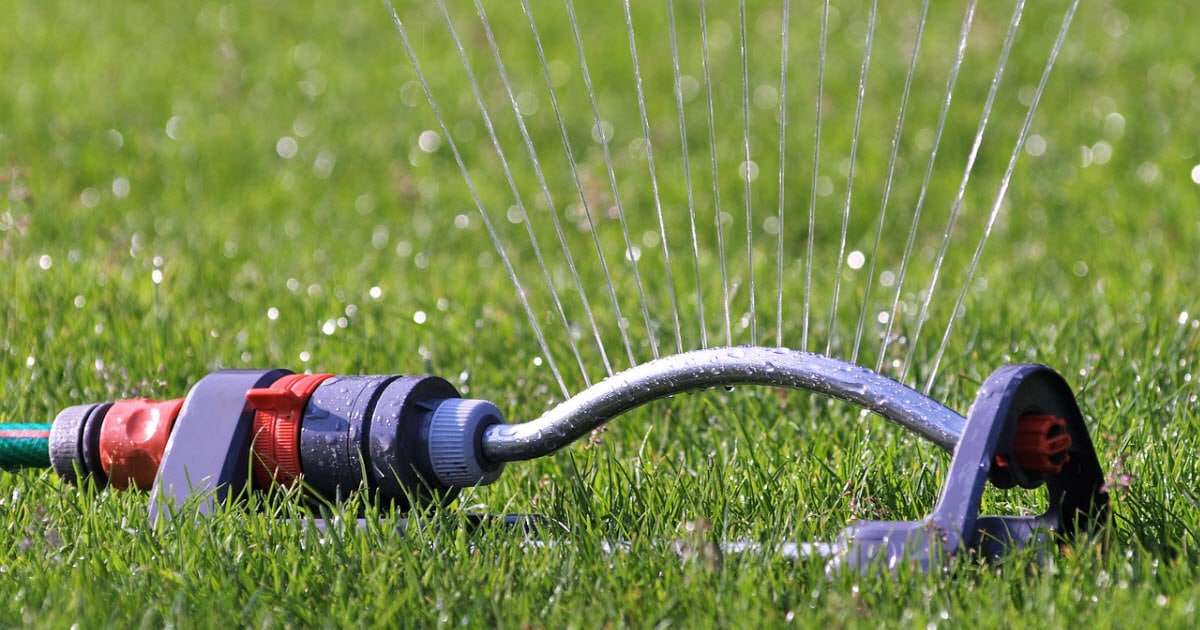Home>Gardening Tips and Tricks>Eco-Friendly Gardening>What Runs In The Backyard Yet Never Moves


Eco-Friendly Gardening
What Runs In The Backyard Yet Never Moves
Modified: January 22, 2024
Discover the joy of eco-friendly gardening with our guide to what runs in the backyard yet never moves. Create a sustainable oasis while reducing your carbon footprint.
(Many of the links in this article redirect to a specific reviewed product. Your purchase of these products through affiliate links helps to generate commission for Chicagolandgardening.com, at no extra cost. Learn more)
Table of Contents
Introduction
Imagine stepping into your backyard, expecting to see the usual sights and sounds of nature. But instead, you find yourself faced with a puzzling mystery – everything appears to be perfectly still, as if frozen in time. The trees don’t sway in the breeze, the birds don’t chirp, and even the flowers seem to be suspended in motion.
This phenomenon might seem odd at first, but it’s not uncommon in certain gardens and outdoor spaces. It raises the question: what could be causing this complete lack of movement?
In this article, we will delve into the mysterious world of the motionless backyard and explore some possible explanations for this peculiar phenomenon. From statues and sculptures to optical illusions and supernatural entities, we will examine various factors that could contribute to the stillness in your outdoor oasis. By the end of this article, you may have a newfound perspective on the seemingly motionless environment that surrounds you.
The Mystery of the Backyard
When you step outside into your backyard, you expect to encounter a vibrant and dynamic environment. The wind rustles through the leaves, birds flit from tree to tree, and the flowers dance in the sunlight. But what happens when the usual liveliness gives way to a stillness so profound that it borders on surreal?
The mystery of why a backyard might appear motionless is a perplexing one. It challenges our understanding of the natural world and prompts us to explore unconventional explanations. The absence of movement raises questions about the underlying forces that govern our outdoor spaces.
One possible explanation for this enigma is the presence of statues and sculptures. These artistic installations can create an illusion of stillness, as if time itself has come to a halt. A carefully placed statue can blend seamlessly into the surroundings, causing us to pause and question whether it is indeed a living being or a frozen work of art.
Another factor that could contribute to the immobility of a backyard is the presence of outdoor furniture. When arranged in a particular way, chairs, tables, and loungers can give the impression that the space is uninhabited. These stationary objects can trick our senses into perceiving a static environment.
The plants and trees in our backyard also play a significant role in the perceived motionlessness. On calm days, they may appear completely still, their branches and leaves motionless. However, even the slightest breeze can bring them to life, adding a sense of dynamism to the surroundings. It’s essential to observe carefully and distinguish between genuine stillness and the temporary dormancy of nature.
A body of water, such as a pond or a water feature, can also contribute to the stillness of a backyard. When the water is calm and undisturbed, it creates a reflective surface that gives the impression of a motionless environment. The absence of ripples or splashes can be misleading, despite the constant flow of water beneath the surface.
The presence of wildlife and birds can further enhance the illusion of a motionless backyard. Many animals are highly adept at remaining still when they sense danger or when observing their surroundings. They can blend into their surroundings with such mastery that we may not even realize their presence, adding to the overall stillness of the environment.
Another possible explanation for the motionless backyard lies in the use of invisible boundary markers. These markers, such as fences or hedges, create a visual barrier that demarcates the space and gives the impression of a frozen boundary. They can create a sense of containment, making the yard appear motionless even when the world outside is in constant motion.
Optical illusions are yet another factor that can contribute to the mystery of a motionless backyard. Patterns, colors, and shapes can trick our eyes into perceiving stillness, even when there is movement happening around us. The careful arrangement of elements and the manipulation of perspective can create a captivating visual experience, lulling us into perceiving a static environment.
Lastly, some may attribute the motionlessness to supernatural or paranormal entities. While these explanations may challenge our scientific understanding, they contribute to the intrigue and fascination surrounding the mystery of the backyard. Belief in mystical forces and otherworldly beings has been a part of human culture for centuries, adding a layer of enchantment to the perceived stillness.
Possible Explanations
When confronted with a motionless backyard, there are several potential explanations to consider. Let’s explore some of the possibilities:
- Statues and Sculptures: The presence of statues and sculptures in the backyard can create the illusion of a frozen environment. These art installations, when strategically placed, can blend seamlessly with the natural surroundings, tricking our eyes into perceiving stillness.
- Outdoor Furniture: Arranged in a particular way, outdoor furniture can give the impression that the backyard is uninhabited. The stationary chairs, tables, and loungers create an atmosphere of stillness, causing us to question the lack of movement.
- Plants and Trees: While plants and trees can sway and rustle in the wind, they may appear motionless on calm days. However, even in apparent stillness, these living organisms are constantly growing and evolving, adding to the overall balance of nature.
- Pond or Water Feature: The presence of a body of water, such as a pond or water feature, can contribute to the stillness of the backyard. When the water is calm and undisturbed, it creates a reflective surface that gives the illusion of motionlessness.
- Wildlife and Birds: Many animals are adept at remaining still when they sense danger or when observing their surroundings. Their ability to blend into their environment can add to the perceived stillness of the backyard, even when there is underlying movement.
- Invisible Boundary Markers: Fences, hedges, and other invisible boundary markers can create a visual barrier that gives the impression of a frozen boundary. They create a sense of containment, contributing to the overall stillness of the backyard.
- Optical Illusions: The careful arrangement of patterns, colors, and shapes can create optical illusions that trick our eyes into perceiving stillness. Manipulating perspective and visual cues can enhance the experience of a motionless environment.
- Supernatural or Paranormal Entities: While more esoteric, the belief in supernatural or paranormal entities adds a layer of intrigue to the mystery of a motionless backyard. Whether it’s the presence of ghosts or other mystical forces, these explanations captivate the imagination.
While each of these explanations offers a different perspective, it’s essential to approach the mystery of the motionless backyard with an open mind. Observing and exploring the environment can help uncover the truth behind the stillness, providing a deeper understanding of the natural world around us.
Statues and Sculptures
One possible explanation for the motionless backyard phenomenon is the presence of statues and sculptures. When strategically placed, these artistic installations can create the illusion of a frozen environment, captivating the observer’s attention and causing them to question the lack of movement.
Statues and sculptures have long been used to adorn outdoor spaces, adding aesthetic appeal and imbuing them with a sense of artistic elegance. They come in various forms, from realistic representations of human figures to abstract shapes that evoke different emotions and interpretations.
When positioned amidst the natural elements of a backyard, statues can seamlessly blend with their surroundings, blurring the line between artifice and nature. The use of materials such as stone, bronze, or marble further enhances this integration, as they share a similar texture and appearance to elements found in the environment.
As the observer gazes upon these static figures, a sense of stillness permeates the surroundings. They become the focal point, commanding attention and capturing the imagination. In that moment, everything else seems to fade away, contributing to the perception of a motionless backyard.
But it’s important to note that while statues and sculptures may create an illusion of lifelessness, they are themselves products of human creativity and intervention. They stand as representations of movement, frozen in time, and beckon us to explore the tension between the static and the dynamic.
Moreover, the presence of statues and sculptures in the backyard adds depth and meaning to the space. They can evoke a range of emotions and provoke contemplation, inviting us to engage with the environment on a deeper level. This interaction between art and nature enriches the overall experience of the backyard.
So, the next time you find yourself in a seemingly motionless backyard, take a closer look at the statues and sculptures around you. Appreciate their artistry and the unique perspective they offer. While they may contribute to the stillness, they also invite you to ponder the mysteries of existence and the delicate balance between movement and stasis.
Outdoor Furniture
Another possible explanation for the motionless backyard is the presence of outdoor furniture. When arranged in a particular way, these stationary objects can create a perception of stillness, making the space appear uninhabited and devoid of movement.
Outdoor furniture, such as chairs, tables, loungers, and benches, serves both functional and aesthetic purposes. It provides a place for relaxation, socialization, and enjoyment of the outdoor environment. However, when these pieces of furniture remain unoccupied, they can contribute to the illusion of a motionless backyard.
The strategic placement of furniture can give the impression that the space is untouched and devoid of activity. Rows of neatly aligned chairs or tables can create a sense of order and stillness, implying that no one is currently using the area.
Additionally, the materials used in outdoor furniture, such as wood, metal, or plastic, often have a smooth and polished surface. This sleek appearance can further enhance the notion of immobility, as it contrasts with the rough and organic textures of nature.
It’s also worth considering the psychological impact of seeing empty outdoor furniture. When we encounter a chair without someone sitting in it, our brain instinctively associates it with stillness. We expect movement to accompany the presence of a person occupying the seat, so the absence of a human figure reinforces the perception of motionlessness.
However, it’s important to remember that outdoor furniture is not inherently motionless. Their primary purpose is to provide comfort and function, and they can come to life when utilized. People, both young and old, can gather around tables for lively conversations, or lounge on recliners to relax and soak in the surroundings.
So, the next time you find yourself in a backyard seemingly devoid of movement, take a moment to consider the role of the outdoor furniture. While it can contribute to the perception of stillness, it also represents the potential for activity, socialization, and enjoyment in the space.
Plants and Trees
When we think of motion in a backyard, our attention often turns to the plants and trees that populate the landscape. However, these living organisms can contribute to the perception of stillness in several ways.
On calm days, the plants and trees in our backyard may appear completely motionless. Their branches and leaves remain perfectly still, as if frozen in time. This lack of movement can create an atmosphere of tranquility and serenity.
But even in apparent stillness, plants and trees are far from motionless. They are constantly engaging in vital life processes, such as photosynthesis, growth, and reproduction. The absence of visible movement does not negate their active presence in the ecosystem.
However, when a gentle breeze sweeps through the backyard, it awakens the plants and trees from their seemingly static state. The leaves begin to rustle, branches sway, and the entire landscape comes alive with a subtle movement. This contrast between stillness and gentle motion adds depth and dynamism to the environment.
Furthermore, the seasonality of plants and trees can contribute to the perception of stillness. During the winter months, when deciduous trees shed their leaves, the bare branches can create a visually striking but seemingly motionless landscape. However, this dormancy is only temporary, as new growth emerges in the spring, bringing vibrant colors and renewed vitality to the backyard.
Another factor to consider is the interaction between plants, animals, and insects. Many plants rely on pollinators, such as bees and butterflies, to facilitate reproduction. These interactions can be subtle and easily missed by the unobservant eye, contributing to the illusion of a motionless environment.
Ultimately, the perceived motionlessness of plants and trees highlights the intricate balance of nature. While they may appear still on the surface, they are constantly engaged in a myriad of processes, contributing to the overall harmony of the backyard ecosystem.
So, the next time you find yourself in a seemingly motionless backyard, take a closer look at the plants and trees. Observe their subtle movements, notice the changing seasons, and appreciate the intricate dance of life happening all around you.
Pond or Water Feature
A pond or water feature can add a touch of tranquility and beauty to a backyard. However, the presence of still water can contribute to the perception of motionlessness in the environment.
When a body of water, such as a pond or water feature, is still and undisturbed, it creates a reflective surface that gives the illusion of a motionless backyard. The calm water acts as a mirror, reflecting the surrounding landscape and making it appear static.
The absence of ripples or splashes on the water’s surface can be misleading, as it suggests a lack of movement. However, beneath the tranquil facade, there is constant flow and movement happening. Water circulates, plants grow, and aquatic life thrives in this hidden world.
Additionally, the stillness of a pond or water feature can create a sense of serenity and peace. This quiet environment invites contemplation and reflection, allowing us to connect with nature on a deeper level.
Furthermore, the presence of water in a backyard can attract wildlife and birds. These creatures may visit the water source for drinking, bathing, or seeking refuge. Their stillness as they engage in these activities can contribute to the overall perception of a motionless environment.
It’s important to note that while a pond or water feature may give the illusion of motionlessness, it holds a vibrant ecosystem within its depths. Plants, insects, fish, and other aquatic organisms thrive in this watery habitat, contributing to the overall balance and biodiversity of the backyard.
So, the next time you find yourself in a seemingly still backyard, take a moment to appreciate the beauty of the reflective water. Look beyond the surface to discover the hidden world teeming with life beneath.
Wildlife and Birds
When exploring the motionless backyard phenomenon, it’s important to consider the role of wildlife and birds. These creatures have a unique ability to remain still, blending seamlessly with their surroundings and contributing to the perception of a motionless environment.
Many animals and birds have evolved camouflage mechanisms to help them hide from predators or stalk their prey undetected. By remaining perfectly still, they can effectively disappear into the background, appearing as if they are part of the static landscape.
For example, a motionless rabbit nestled amidst the foliage or a bird perched on a branch can easily go unnoticed unless one looks closely. The stillness of these creatures adds to the illusion of a motionless backyard.
Furthermore, the attentive behavior of wildlife and birds can contribute to the perception of stillness. They are highly alert and responsive to their environment, freezing in place when they sense danger or when observing their surroundings.
Additionally, birds have the ability to remain still on branches or in nests for extended periods, waiting patiently for opportunities to capture prey or protect their territory. Their statuesque poses can create an atmosphere of silence and stillness, even in an otherwise bustling environment.
Moreover, the presence of birds in a backyard adds a touch of liveliness and enchantment. Their melodious songs and delicate movements can provide a beautiful contrast to the perceived stillness.
It’s important to appreciate the role of wildlife and birds in the ecosystem. While their stillness may contribute to the motionless backyard phenomenon, they also play a vital role in pollination, seed dispersal, and maintaining the delicate balance of nature.
So, the next time you find yourself in a seemingly motionless backyard, indulge in the subtle nuances of wildlife and birds. Observe their remarkable ability to remain still and appreciate the dynamic harmony they bring to the environment.
Invisible Boundary Markers
One intriguing explanation for the motionless backyard phenomenon lies in the presence of invisible boundary markers. Fences, hedges, or other visual barriers can create a perception of stillness by defining the borders of the backyard and giving the impression of a frozen boundary.
These invisible boundary markers act as psychological barriers, creating a visual separation between the backyard and the external world. They can imbue a sense of containment and isolation, contributing to the overall perception of a motionless environment.
When we encounter these visually defined boundaries, our perception of movement is influenced. Our brains interpret the space within these markers as contained and separate from the surroundings. As a result, the stillness within this defined space is emphasized.
Moreover, the materials and design of these boundary markers can enhance the illusion of motionlessness. A solid fence, for instance, creates a seamless visual barrier, giving the impression that movement ceases beyond its structure.
Similarly, a well-maintained hedge creates a dense and uniform appearance, adding to the sense of a fixed and immobile backdrop. These earthy elements, when carefully cultivated and shaped, contribute to the overall perception of stillness in the backyard.
It’s important to note that while these invisible boundary markers may contribute to the motionless backyard phenomenon, they serve practical purposes as well. They help to define property boundaries, provide privacy and security, and can even create microclimates and habitats for wildlife.
So, the next time you find yourself in a seemingly motionless backyard, take a moment to observe the invisible boundary markers. Appreciate the symbolic and practical functions they serve, while contemplating the effect they have on our perception of the space.
Optical Illusions
Optical illusions can play a fascinating role in creating the illusion of a motionless backyard. By manipulating patterns, colors, shapes, and perspective, these visual tricks can deceive our eyes and contribute to the perception of stillness.
One common optical illusion that can create a sense of motionlessness is a repeating pattern. When our eyes encounter a perfectly repetitive design, it can create a sensation of stillness, as if the pattern is frozen in time.
Color perception also plays a significant role in optical illusions. For instance, cool and muted color schemes can give the impression of calmness and tranquility, adding to the perception of stillness in the backyard.
Additionally, the careful arrangement of shapes and lines can contribute to the motionless illusion. Parallel lines or symmetrical arrangements can create a sense of stability and calmness, reinforcing the perception of a static environment.
Perspective is another powerful tool in creating optical illusions of stillness. By manipulating the depth and scale of objects, one can create a sense of distance and immobility. This visual distortion can trick our brains into perceiving a motionless backdrop.
It’s important to note that optical illusions can be intentionally designed or naturally occurring. For example, the way sunlight filters through branches or the reflection of objects on water can create mesmerizing visual effects that enhance the perception of stillness.
Furthermore, the perception of stillness through optical illusions challenges our understanding of reality. It reminds us that our senses can be easily manipulated, and what we perceive may not always reflect the true nature of the world around us.
So, the next time you find yourself in a seemingly motionless backyard, take a moment to appreciate the role of optical illusions. Recognize the power they hold in shaping our perception, and allow yourself to marvel at the intricate nature of visual deception.
Supernatural or Paranormal Entities
While more esoteric, some individuals may attribute the phenomenon of a motionless backyard to supernatural or paranormal entities. Belief in mystical forces and otherworldly beings has been a part of human culture for centuries, adding a layer of intrigue and mystery to the perception of stillness in outdoor spaces.
For those who hold these beliefs, the possibility of unseen entities lurking in the backyard can provide an explanation for the absence of movement. Some may believe that spirits or ghosts reside in the environment, interacting with the physical world in ways that defy our understanding of natural laws.
This perception of stillness may also be linked to folklore and legends. Various cultures have stories of mystical creatures, such as fairies or nature spirits, that are said to inhabit certain places in nature. These beings are often described as existing outside of our normal perception of time and motion.
Personal experiences and encounters with the supernatural can also shape one’s belief in the motionless backyard phenomenon. Individuals may recount stories of strange occurrences, inexplicable phenomena, or encounters with otherworldly entities, further fueling their belief in the presence of the supernatural.
It’s important to recognize that the belief in supernatural or paranormal entities is subjective and varies among individuals. While scientific evidence may not support such claims, these beliefs contribute to the enchantment and fascination surrounding the perception of a motionless backyard.
So, for those who embrace the possibility of supernatural entities, the motionless backyard may be seen as a mystical and unique experience, inviting contemplation and exploration of the unknown.
Conclusion
The motionless backyard phenomenon is a captivating mystery that challenges our perception and understanding of the natural world. As we have explored in this article, there are several potential explanations for this perceived stillness.
From the presence of statues and sculptures to the arrangement of outdoor furniture, each factor plays a role in creating the illusion of motionlessness. Plants and trees, water features, wildlife, invisible boundary markers, optical illusions, and even beliefs in supernatural entities all contribute to the overall perception of a motionless backyard.
However, it’s important to remember that while these explanations offer insights into the phenomenon, they are not mutually exclusive. Often, multiple factors can be at play simultaneously, interacting to create a unique and captivating experience.
As we contemplate the mystery of the motionless backyard, we are reminded of the complex dynamics that shape our outdoor spaces. Nature is constantly in motion, even when it appears still to our eyes. The subtle movements of plants, the flow of water, and the activities of wildlife all contribute to a dynamic and ever-changing environment.
Ultimately, the perception of stillness in a backyard invites us to pause and observe the intricate details of nature. It encourages us to appreciate the balance between movement and stasis, the interplay of the organic and the artificial, and the magic that lies within the ordinary.
So, the next time you step into your backyard and feel a sense of motionlessness, take a moment to embrace the mystery. Engage with the environment, observe the subtle nuances, and immerse yourself in the beauty that exists within the apparent stillness.
For in the motionless backyard, there is a world waiting to be discovered and a sense of wonder that transcends the boundaries of perception.






